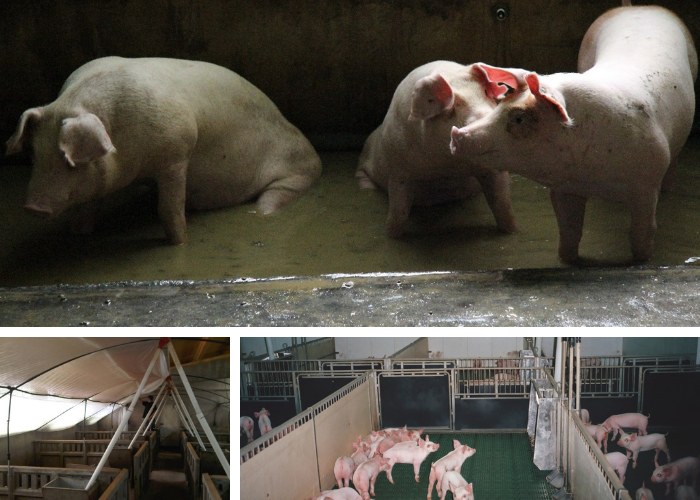Tail biting, tail docking and Animal Welfare
Tail biting is a serious problem that production centres intend to prevent. Not only due to the economic loss it causes, but also because it compromises the well-being and health of the animals.
Tail biting involves destructive chewing of the tails of pigs and is caused when a bleeding bitten tail becomes attractive to other animals in the same group. Lots of factors can trigger this behaviour, internal and external. Tail biting is mostly the result of boredom, insufficient space (high stocking densities) and stimulation, and frustration. It occurs mainly in fattening pigs and when they cannot express their natural behaviour or are not provided with the adequate conditions (factors such as feed intake, poor environment and bad air quality).
Principal consequences of tail-biting:
- Lower carcass weight, condemned and trimmed.
- Economic loss.
- Health issues.
- Antibiotic usage.
There are many strategies to prevent tail biting. One of the most problematic ones is tail docking as it can cause an acute stress response and worsen the health of the animals. This post clarifies the critical points we must pay attention to if we want to prevent tail biting, to guide the decision-making process if we finally adopt tail-docking and specify the effects this measure brings.
Tail docking
Tail docking is considered a non-desirable measure to prevent tail biting among pigs for animal welfare concerns.
» The effectiveness of tail docking in preventing tail biting is limited, since it reduces the symptoms of a behavioral disorder, but does not address the underlying causes.
Although from a practical standpoint the welfare risks arising from tail docking may appear to be negligible compared to those arising during and after tail biting outbreaks, it should be considered that, apart from acute physiological and behavioral responses, tail docking may also elicit long-term effects on weight gain, tail stump sensitivity and animal freedom to express their normal behavior. Such chronic effects have been poorly investigated so far, which is why we must consider deeply to adopt tail docking and take this measure.

Responses to tail docking
| Acute responses | Long-term effects |
|---|---|
| Cortisol
Hematology Other blood parameters Behavioral responses Vocalization |
Weight gain
Chronic pain Infection Communication Behavioral redirection |
Decision tree to adopt tail docking

Tips to prevent tail biting and avoid tail docking
1. Enrinchment material
Potential indicators of ineffective or insufficient:
- Bitten tails
- Skin lesions
- Loss of interest
- Rooting in dung
- Competition for use of enrichment materials
- Belly nosing
What?
- Long chopped straw
- Alfalfa
- Hemp rope
- Change the place
- Chewable
- Root in it
Why? Explore the environment: Rooting, sniffing, biting and chewing
When? All pigs, all times
How much does it cost?
- 25% of costs in fattening
- 8% to 4% in breeding units
Enrichment material: When is it enough?
How do I know if I’m doing it right?
First and foremost, look at your pigs! Are they interested in the material you have provided, or are they manipulating other pigs or pen fittings instead? Are they competing for the material?
Are there any disadvantages?
Straw and roughage can also be used in pens with slatted floors – countries rearing pigs with intact tails report that when using these materials, slurry blockages are rare. Be aware of the origin of the enrichment material to avoid introducing contagious diseases within the production system
| 100% – 86.4% | 86.3% – 18.1% | 18% – 0% |
|---|---|---|
| Maximum exploratory behaviour – no additional material required | Intermediate exploratory behaviour – no additional material required, altough you may want to reconsider if your figure is close to the lower end | Minimal exploratory behaviour – introduction of enrichment materials recommended |

Image: Farms with poor conditions that worsen Animal Welfare
If a tail-biting outbreak occurs, it is important to immediately provide the pigs with a lot of distraction. A mixture of different, interesting and manipulable materials can help. Try using some of the following: branches with leaves, ropes (with knots), wood chip, hay, straw, or other edible material.
2. Thermal comfort, air quality and light
Potential indicators of poor quality
- Lack of cleanliness
- Restlessness/aggression
- Huddling
- Shivering
- Playing with water and manure
- Reduced appetite
- Pigs laying on their sides and/or far apart
- Defecating in the resting area
- Panting, sneezing or coughing
- Conjunctivitis
What?
- Temperature
- Lack or high air flow over sleeping areas
- Dust, ammonia, CO2
- No direct sunlight
- 40 lux for 8 h a day
Why? Limited capacity to regulate body temperature
How?
- Automatic reliable heating systems
- Curtains in windows
- No in semi-darkness
How much does it cost? Depending on the country
| Element | Level | Diagnostic | Observations |
|---|---|---|---|
| CO2 | Max of 3000 ppm | Ventilation efficacy | Min / max |
| NH3 | < 20 ppm | Hygiene | Pits |
| COz | < 10 ppm | Heating system | |
| CH4 | 0 ppm | Fermentation | Pits |
| SH2 | 0 ppm | Toxicity for people and pigs | |
| Dust | < 2.4 mg/m3 | Particle size and concentration | The lower the worst. Less than 5 µ arrives to lung alveolus |
3. Sanitary conditions and diet
Article about Sanitary conditions, diet and amino acid supply over damaging behaviour: A link between damaging behaviour in pigs, sanitary conditions, and dietary protein and amino acid supply
Treatments (from weaning to slaughter):
- 2 sanitary conditions, Low and High
- 2 protein levels, Low and High
- 2 amino acid supplementation levels:
- 20% more of Thr, Trp and Met
- 8 groups in total
- 576 pigs, 64 pens, 8 pens per treatment, 9 pigs per pen
4 rooms for each sanitary condition
Sorted by weight
2 pens per diet and room
4. Health and fitness factors to prevent tail docking in pigs
What? Regular and planned visits of your trained veterinarians
Why? Avoid tail biting and business profit
How?
- Weaning at 28 days
- Hygiene
- Vaccinations
- Analyses
- Biosecurity
- Health replacements
- How much does it cost?: Outweighed by the benefits
5. Competition signals
Potential indicators of poor quality:
- Low body condition scores
- Variability in body size within a pen
- Skin lesions on hind quarters (food competition)
- Skin lesions on forequarters (space competition)
- Fights around feeders
- Pigs waiting to use feeders
- Poor distribution of pigs in each area of the pen
What?
- Enough space for each pig for food, drink and space to rest
- Pen structure
- Pen allowances
- Areas to feed, rest, play, toilet area
Why?
- Stress
- Confrontation
- Pigs like to forage and feed together
How?
- Similar size of pigs in a pen
- At weaning, mixing minimized
- Keep litter mates together as much as possible
- Move small piglets to a pen with extra facilities
How much does it cost?
- Depending how good or bad facilities you have or how many pigs are with tail bitten
- 17 cm per piglet (feeder)
- 22 cm per fattener (feeder)
6. Diet
Potential indicators of poor quality:
- Low body condition score
- Variation in weight
- Poor carcass classification
- High incidence of stomach and intestinal ulcers
- High incidence of tail or ear necrosis
What?
- Dietary fiber, NDF, ADF, NSP, soluble, insoluble, …
- Tryptophan
- Water
- Salt and electrolytic balance
Why? High performance
How?
- Formulation
- Particle size
- Sugar beet pulp or similar raw materials (fiber structure)
- 1 drinker/12 pigs
- Flow rates and quality
How much does it cost?
- Depending how good or bad facilities you have or how many pigs are with tail bitten
- 17 cm per piglet (feeder)
- 22 cm per fattener (feeder)
7. Pen structure and cleanliness contitions to control that will prevent tail biting
Potential indicators of an unsuitable pen structure/lack of cleanliness:
- Presence of manure on the pigs’ bodies
- Increased disease (lameness, diarrhoea, respiratory infections).
What?
- Increase level of noxious gases
- Increasing risk of disease
- Overcrowding
- Uninteresting enrichment material when dirty
Where?
- Well defined areas for resting and dunging specially in pens with partial slatted floor
- Feeding, watering and resting areas should be clean at all time
How?
- Investigate pen layout
- Draughts of air
- Where does pig defecate?
Why?
- Heated floors in resting areas
- Remove dust and ammonia
When things are wrong...
First signs:
- Hanging, clamped tails
- Tail wagging
- Hairless tails,
- Restlessness and bite marks
Remove the biter and treat injured pigs, add fresh enrichment material (such as rope, fresh wood, branches, straw,...), and check the key factors reviewed before.





